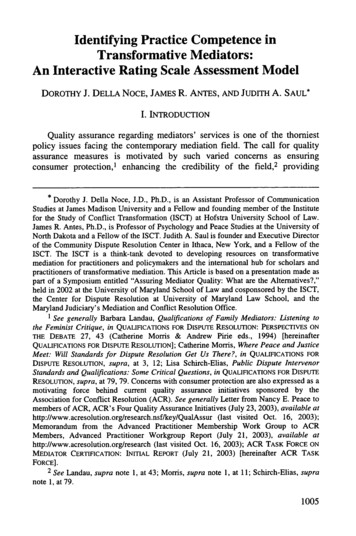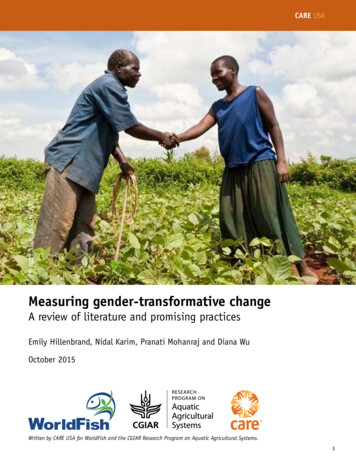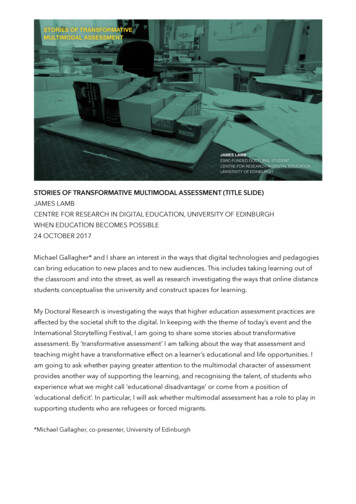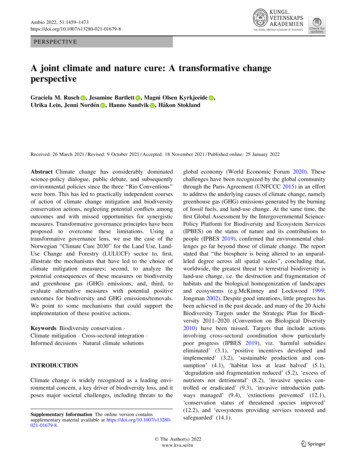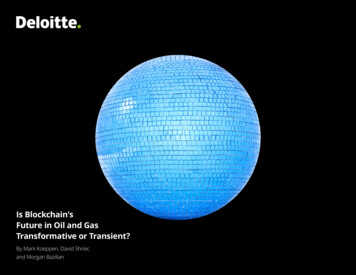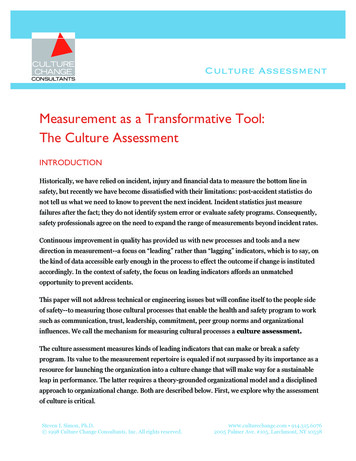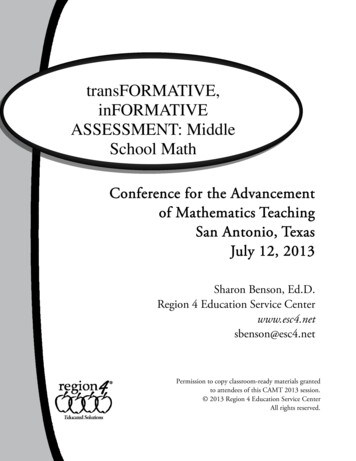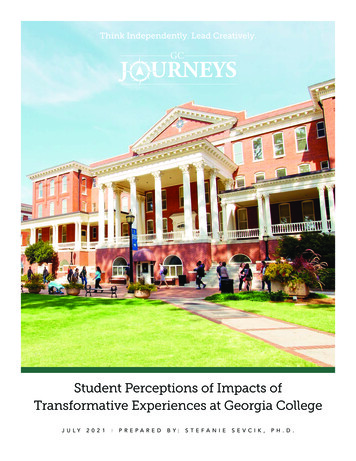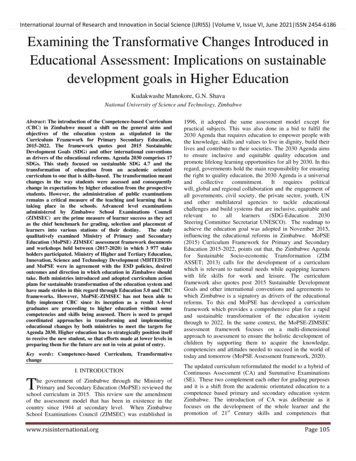
Transcription
International Journal of Research and Innovation in Social Science (IJRISS) Volume V, Issue VI, June 2021 ISSN 2454-6186Examining the Transformative Changes Introduced inEducational Assessment: Implications on sustainabledevelopment goals in Higher EducationKudakwashe Manokore, G.N. ShavaNational University of Science and Technology, ZimbabweAbstract: The introduction of the Competence-based Curriculum(CBC) in Zimbabwe meant a shift on the general aims andobjectives of the education system as stipulated in theCurriculum Framework for Primary Secondary Education,2015-2022. The framework quotes post 2015 SustainableDevelopment Goals (SDG) and other international conventionsas drivers of the educational reforms. Agenda 2030 comprises 17SDGs. This study focused on sustainable SDG 4.7 and thetransformation of education from an academic orientedcurriculum to one that is skills-based. The transformation meantchanges in the way students were assessed and consequentlychange in expectations by higher education from the prospectivestudents. However, the administration of public examinationsremains a critical measure of the teaching and learning that istaking place in the schools. Advanced level examinationsadministered by Zimbabwe School Examinations Council(ZIMSEC) are the prime measure of learner success as they actas the chief benchmark for grading, selection and placement oflearners into various stations of their destiny. The studyqualitatively examined Ministry of Primary and SecondaryEducation (MoPSE) ZIMSEC assessment framework documentsand workshops held between (2017-2020) in which 3 977 stakeholders participated. Ministry of Higher and Tertiary Education,Innovation, Science and Technology Development (MHTEISTD)and MoPSE were in agreement with the ESD policies, desiredoutcomes and direction in which education in Zimbabwe shouldtake. Both ministries introduced and adopted curriculum actionplans for sustainable transformation of the education system andhave made strides in this regard through Education 5.0 and CBCframeworks. However, MoPSE-ZIMSEC has not been able tofully implement CBC since its inception as a result A-levelgraduates are proceeding to higher education without somecompetencies and skills being assessed. There is need to propelcoordinated approaches in transforming and implementingeducational changes by both ministries to meet the targets forAgenda 2030. Higher education has to strategically position itselfto receive the new student, so that efforts made at lower levels inpreparing them for the future are not in vein at point of entry.Key words: Competence-based Curriculum, TransformativechangeI. INTRODUCTIONThe government of Zimbabwe through the Ministry ofPrimary and Secondary Education (MoPSE) reviewed theschool curriculum in 2015. This review saw the amendmentof the assessment model that has been in existence in thecountry since 1944 at secondary level. When ZimbabweSchool Examinations Council (ZIMSEC) was established inwww.rsisinternational.org1996, it adopted the same assessment model except forpractical subjects. This was also done in a bid to fulfil the2030 Agenda that requires education to empower people withthe knowledge, skills and values to live in dignity, build theirlives and contribute to their societies. The 2030 Agenda aimsto ensure inclusive and equitable quality education andpromote lifelong learning opportunities for all by 2030. In thisregard, governments hold the main responsibility for ensuringthe right to quality education, the 2030 Agenda is a universaland collective commitment. It requires politicalwill, global and regional collaboration and the engagement ofall governments, civil society, the private sector, youth, UNand other multilateral agencies to tackle educationalchallenges and build systems that are inclusive, equitable andrelevanttoalllearners(SDG-Education2030Steering Committee Secretariat UNESCO). The roadmap toachieve the education goal was adopted in November 2015,influencing the educational reforms in Zimbabwe. MoPSE(2015) Curriculum Framework for Primary and SecondaryEducation 2015-2022, points out that, the Zimbabwe Agendafor Sustainable Socio-economic Transformation (ZIMASSET; 2013) calls for the development of a curriculumwhich is relevant to national needs while equipping learnerswith life skills for work and leisure. The curriculumframework also quotes post 2015 Sustainable DevelopmentGoals and other international conventions and agreements towhich Zimbabwe is a signatory as drivers of the educationalreforms. To this end MoPSE has developed a curriculumframework which provides a comprehensive plan for a rapidand sustainable transformation of the education systemthrough to 2022. In the same context, the MoPSE-ZIMSECassessment framework focuses on a multi-dimensionalapproach to assessment to ensure the holistic development ofchildren by supporting them to acquire the knowledge,competencies and attitudes needed to succeed in the world oftoday and tomorrow (MoPSE Assessment framework, 2020).The updated curriculum reformulated the model to a hybrid ofContinuous Assessment (CA) and Summative Examinations(SE). These two complement each other for grading purposesand it is a shift from the academic orientated education to acompetence based primary and secondary education systemZimbabwe. The introduction of CA was deliberate as itfocuses on the development of the whole learner and thepromotion of 21st Century skills and competences thatPage 105
International Journal of Research and Innovation in Social Science (IJRISS) Volume V, Issue VI, June 2021 ISSN 2454-6186promote survival in any environment through completion ofreal-world activities (MoPSE Assessment framework, 2020).The inclusion of CA implies a change in the way students areassessed and as a result a change in the prospective student athigher education entry point. In other words, higher educationanticipated a student with wider and relevant skills,competencies and attitudes. MoPSE (2015) purports that thedecision to develop the Curriculum Framework was made inthe context of the government‘s focus on preparingZimbabwean learners for the needs of the 21st century,growing concerns amongst policy makers and keystakeholders regarding the relevance of the education systemand the changes in global education standards. This is in linewith the Sustainable Development Goals (SDGs) includinggoal 4.7 that ensures all learners acquire the knowledge andskills needed to promote sustainable development, including,among others, through education for sustainable 2030Steering Committee Secretariat).In this regard, the first examinations in the updated curriculumwere written in 2018 with the intention of includingcontinuous assessment on candidates‘ profile. However, theassessment system could not take off with a complete packageof assessment for the learner as anticipated. This was due to anumber of logistical and technical challenges that wereexperienced by all stakeholders involved. Since then studentshave been channelled into higher education without thecontinuous assessment component for three consecutive years.That translates to four A level examinations for bothNovember and June sessions. This study assesses theimplication of the changes made by MoPSE-ZIMSEC on itsassessment model to higher education entry point. This is inview of sustainable development goal 4.7 that continuousassessment was intended to address directly. If highereducation had prepared for this learner what changes were putin place at entry point to fulfil sustainable development thisgoal? If the higher education had not prepared for this learnerhow are they adjusting now in preparation for imminentchanges? It is upon this background that this paper sort tointerrogate the implications of the assessment changes onsustainable development goal 4.7 at the entry point in HigherEducation and university in particular. The following researchquestions guided this study: What changes were made to the Zimbabwean nt?What are the implications of the changes to highstakes assessments on sustainable development at thepoint of entry in higher education?How has higher education especially university,contributed to the development of MoPSE-ZIMSECassessment framework?What preparations were put in place by university toreceive the new student from the school forcontinuity of sustainable development goal?www.rsisinternational.orgIt is envisaged that the study will establish the measures put inplace at entry point by higher education in preparation fordifferent student. Support continuity of sustainabledevelopment goal 4.7 or expose gaps thereof that may existbetween higher education and MoPSE. Since the introductionof CBC there has been any literature that traces and addressesdirectly the relationship between MHTEISTD and MoPSEZIMSEC in curriculum transformation. There is need tounderstand CBC demands in order to create the basis forextended communication and cooperation between highereducation and MoPSE-ZIMSEC, increase the quality andequity of assessment, increase accountability at differentlevels, and inform system performance for sustainabledevelopment.Conceptual FrameworkTransformative change as seen in the updated MoPSEZIMSEC assessment model guided this study. The modelembraces holistic approaches to assessment of competencieson a continuum of knowledge, skills, abilities, values andtraits. (Mersmann et al. 2014) defines transformational changeas a structural change that alters the interplay of institutional,cultural, technological, economic and ecological dimensionsof a given system. It will unlock new development paths,including social ractices and worldviews.Fig 1: Transformative change in MoPSE –ZIMSEC assessmentWhen interpreted from transformative education point ofview, the purpose of education is to empower learners to seethe social world differently and through an ethical lens, so thatthey will challenge and change the status quo as agents ofchange. The function of ESD is to fuel the natural passion andgenius of the student, rather than be the protectors ofknowledge, forcing students down a pre-constructed road builtfor the masses. Students have to be encouraged to question theknowledge and methods taught by teachers and to find newinnovative insights. In other words it is intended to encouragestudents, to become active participants in building new andbetter societies even before they leave school (Rüfenacht,2017; Mogren, 2019 and Ng S et al 2018). In this endeavour,the 4.7 goal is set to ensure that all learners acquire theknowledge and skills needed to promote sustainabledevelopment, including, among others, through education forsustainable development and sustainable lifestyles, humanrights, gender equality, promotion of a culture of peace andPage 106
International Journal of Research and Innovation in Social Science (IJRISS) Volume V, Issue VI, June 2021 ISSN 2454-6186nonviolence, global citizenship and appreciation of culturaldiversity and of culture‘s contribution to sustainabledevelopment (SDG-Education 2030 Steering CommitteeSecretariat). In this context, change aims to change not onlypractices, but outcomes, thereby disrupting the status quo.CBC with a CA component was adopted as, shift from atransmissive to a transformative learning model (Berner et al2013). The transformative assessment model which movesaway from a singular final examination to a system ofassessments where multiple forms of assessment become anintegral part of the teaching-learning process, placement andcertification. CA was brought about after the realization thattesting skills exhibited in a summative examination did notmeasure life skills. The former education system trainedstudents to pass the examinations and not to have criticalthinking skills. It was unsuitable to teach sustainability, as itwas very transmissive, teacher-centered approach with anemphasis on cognitive learning and memorization. However,the updated curriculum emphasises on ICT, STEM, Educationfor Sustainable Development and provision of life skills andadvocates for the introduction of industrial attachment forstudents after their Ordinary Level studies (UNESC, 2019;UN & Government of Zimbabwe, 2018). Hence, the authorsbelieve that transformative education is a very valuableapproach to educating for sustainable development. It goesinto the depth of things and brings about a paradigmatic shift.development of current and future society. ESD describes thepractice of teaching for sustainability (Mogren, 2019; Walsand Kieft, 2010; Berner et Al 2013). ESD for 2030 aims tobuild a more just and sustainable world through strengtheningESD and contributing to the achievement of the 17 SDGs.ESD is a key element of the 2030 Agenda for SustainableDevelopment. Its aims form one of the targets of theSustainable Development Goal on education SDG 4.7 and it isconsidered a driver for the achievements of all 17SDGs (UNESCO, in the article; Sustainable DevelopmentGoals - Resources for educators, 2020; Berner et Al 2013).Begashaw in the Foresight Africa 2020 report, acknowledgesthat one-third of the 2030 Agenda journey is alreadycomplete, it is an opportune time to examine Africa‘s progresson the Sustainable Development Goals (SDGs) so far as wellas assess what adjustments to strategies are needed toovercome the remaining obstacles. In the same context, Oneplanet (2021) reports that the new ESD framework for theperiod 2020 – 2030 (ESD for 2030) was developed throughbroad consultations with various stakeholders from 2016 to2018. It focuses on strengthening ESD‘s contribution to theachievement of all 17 SDGs, focusing on policies, learningenvironments, teachers and educators, youth as well ascommunities. It has a particular focus on placing greateremphasis on the contribution of learning content to thesurvival and prosperity of humanity.On the higher education side, the teaching aspect now requiresthat theory be blended with practice in teaching. As a result,the Minimum Bodies of Knowledge and Skills (MBK/S) thatwere introduced to the university curriculum influenceteaching. These require similar programs in differentZimbabwean institutions of higher education to teach 80% ofsimilar content and the difference should be only 20%(MBK/S strategic plan document). This harmonizes the highereducation sector in Zimbabwe, thereby allowing easy transferof students from one institution to the other within the country(Muzira and Maupa, 2020). At the same time prospectivestudents meet more or less the same expectations andstandards at point of entry in higher education. This shiftreflects the perceived need for continuous engagement onsustainability in higher education and the need for sustainabledevelopment. A full-fledged ESD requires the integration ofprimary, secondary, tertiary education and industrialdimensions. However, Berner et al (2013) observes that therehave been few attempts made to guide the effort of designingtransformative ESD programs, with a strategic, whole-systemsapproach that has a scientifically robust definition ofsustainability. The Framework for Strategic SustainableDevelopment (FSSD) is a scientifically rigorous tool with awhole-systems approach for planning within the complexrealms of sustainability.The UNESCO (2019) article for Inclusion of ESD inZimbabwean schools reported that there was progress towardsthe inclusion of ESD in school curricula and activities.However, there were many practical challenges inimplementing an ideal or normative concept of ESD, and tomake it institutionalised in educational systems. The fosteringof lifelong education and inter-departmental engagement andcommunication within the institutions was not clearly broughtto light in most project presentations (Mogren, 2019;UNESCO, 2019). In the same context, Begashaw (2020) notesthat while progress in some areas and countries isencouraging, overall, the region will need to redouble itsefforts if it is to achieve the SDGs by 2030. In the same vein,Tikly (2019) urges that, if education in Africa is to play a rolein transformative change then it will need to be fundamentallyre-oriented away from its current path dependency which ithas inherited since colonial times and which has provedremarkably resilient to change. UNESCO (2019) urgedstakeholders and participants of the Capacity BuildingProgramme on Education for Sustainable Development (CAPESD) to build evidence towards their projects so as toapproach examination and education assessment boards forpolicy changes on assessment types and to also encourageESD inclusion in the curriculum. It was noted in thepresentations of Change Projects that education assessmentdoes not assess the day to day skills and abilities of studentsfor 21st century competencies. Most of the examinations areabout learning a set type of questions with the aim of justpassing the examinations, yet no real life competencies areexamined (UNESCO, 2019).II. LITERATURE REVIEW: TRANSFORMATIVEEDUCATION FOR SUSTAINABLE DEVELOPMENTEducation for Sustainable Development (ESD) is aneducational response to the need to empower students to dealwith the complex challenges associated with sustainablewww.rsisinternational.orgPage 107
International Journal of Research and Innovation in Social Science (IJRISS) Volume V, Issue VI, June 2021 ISSN 2454-6186The world has moved into the fourth revolution, which ischaracterised by innovation and high end or cutting-edgeindustrial advancement. It is fair to say that the dramaticchanges in the world of work and employment means that thefoundation of a new world of education must have the valuesof sustainability and adaptability embedded at the very core(Chihota, 2021; Rüfenacht, 2017) Zimbabwe is no exceptionas the country has adopted a new education curriculum whichis inclined towards modern technological trends. In thisrespect, the adopted model, Ministry of Higher and TertiaryEducation, Innovation, Science and Technology Development(MHTEISTD) 5.0 focuses on innovation and industrialisation.The country adopted Education 5.0 in order to retool andrevive industry using the latest technology. Furthermore,Tagwira (2018) acknowledges that the National Skills Auditconducted by this MHTEISTD in 2017 showed that althoughZimbabwe boasts of over 95% literacy rate, the critical skillsavailability is 38%; which means that there is need to realignand reconfigure higher and tertiary education system.Increasing the literacy rate will not be enough to create asustainable society (Berner et Al 2013). To this end, highereducation, in its obligations to meet the needs of the country,was guided by the Transitional Stabilisation Programme(TSP). TPS was aimed at reconfiguring the Zimbabwe‘seducational system to make it more relevant to the demands ofthe economy and markets. That is, graduates are to beequipped with skills acquisitions that empower them tobecome innovative towards societal development, rather thanacquiring, in universities and colleges, skills that leave themin need of prescriptions on what they should do after college(UN & Government of Zimbabwe, 2018). This was morealigned to Education 3.0, an education system that focusedmore on teaching, research and community service.Conversely, Education 5.0 is a development from the previoushigher and tertiary education system. This kind of educationwas simply unfit to equip students with the knowledgenecessary to solve issues so complex and deeply challengingas is the case with sustainability (Berner et Al 2013). Hence, itis vital to foster the kind of learning that provides studentswith new competencies and a new way of acquiringknowledge to approach the challenges of sustainability. It isnow demanded of the nation‘s higher and tertiary educationsector to not only: teach, research and community serve butinnovate and industrialise Zimbabwe (Muzira, and Maupa,2020; Jonathan, 2021). In pursuit of the 2030 vision, theGovernment released funds for the setting up of innovationhubs at State universities. The first beneficiary universitieswere the National University of Science and Technology(NUST), the Midlands State University (MSU), the Universityof Zimbabwe (UZ), the Harare Institute of Technology (HIT),Zimbabwe Defence University and Chinhoyi University ofTechnology (CUT). The Education 5.0 is centred on theHeritage-based philosophy in shaping future technologythrough innovation and industrialisation (Chihota, 2021;Muzira, and Maupa, 2020). It reaffirms the primacy ofuniversities, polytechnics, teachers‘ colleges and industrialwww.rsisinternational.orgtraining colleges in economic growth, technology transfer andgeneration of new knowledge.It can be noted that policy documents are generally based oncompromises and negotiations about how to introducesomething new. In practice, an implementation plan usuallyfollows documents stating relevant policy. Practicalimplementation of ESD is therefore sometimes said to bepolitical or incongruent with research findings regardingmeasures that support ESD implementation (Mogren, 2019).Although both the challenge of sustainable development andthe call for ESD is worldwide, there is a generalunderstanding that the local realities and manifestations of‗unsustainability‘ are often quite different and deeply rootedin local histories and political and cultural traditions (Walsand Kieft, 2010). Admittedly, designing a transformative ESDprogram with a whole-systems approach is clearly a complextask, and there is little theory or research on how to develop orimplement a sustainability pedagogical design that is systemicand connective (Berner et Al 2013). Begashaw (2020)observes that, even with Africa‘s enthusiasm, without a robustglobal and localized governance structure the SDG agendawill falter. Therefore, the implementation of Education 5.0and the 4.7 goal may not be smooth. Major capacity gaps existfor the achievement of sustainable development, and thiscapacity deficit presents a significant obstacle to achievingsustainable development in Africa. There is lack of trainedacademics that have the capacity to approve new ESD coursesand concepts which resulted in institutional barriers when itcomes to approval and the long period or length of time forprogram to be approved. Lack of policy and strategy relatingto achieving ESD, lack of coordinated institutional effort thatseeks to enhance ESD in different faculties, total lack ofawareness about ESD among academics across disciplines andMinistry of Higher and Tertiary Education failure to provideadequate support to the universities (Wals and Kieft, 2010;Shava, 2020).Nonetheless, Begashaw (2020) argues that to be successful,there is need for effective and coordinated partnerships todomesticate the SDGs that is to fully transpose the SDGecosystem into national and regional planning andimplementation mechanisms, as well as the African Union‘s(AU) Agenda 2063, and to bridge the large financing and datagaps. Tikly (2019) is of the view that, understanding thetensions and contradictions inherent in regional policy inrelation to an analysis of wider processes of change can assistin comprehending the nature and scale of the challenges andpossibilities for implementing transformative education forsustainable development. In this regard, Begashaw (2020)notes that, one major reason to be hopeful for Africa‘sprogress is that the SDGs are in direct alignment with theAfrican Union‘s Agenda 2063 the continent‘s long-term socialand economic transformational blueprint for a prosperouscontinent. The re-orientation towards sustainable developmentof education in Africa requires strengthening and boosting thequality and the efficiency of human capacity developmentinitiatives (education, training, community development andPage 108
International Journal of Research and Innovation in Social Science (IJRISS) Volume V, Issue VI, June 2021 ISSN 2454-6186public awareness programmes) to address governance efficacyand the relevance of education to development and povertyalleviation objectives. ESD has the potential to contributesignificantly to the quality of educational programmes, andthis contribution needs to be pro-actively explored in Africa(Wals and Kieft, 2010).Begashaw (2020) observes that there are many weak links inthe SDGs and not much has been done in changing mindsets;we are continuing to do new things the old way. Like indecades past, key stakeholders continue to work in silos,duplicating interventions with little coordination. Solelyeducating people for sustainability does not necessarilyscrutinize dominant mechanistic paradigms anchored in themindset of our society. Furthermore, it does not deeplyexplore what qualities the individual learner contributes to thelearning experience, as this learning approach still reinforcesthe old, prescriptive, transmissive, teacher-centered learningmodel (Berner et Al 2013). One planet (2021) urges that ESDfor 2030 could be achieved through a threefold approach topromote ESD as a key element of quality education and a keyenabler of all 17 Sustainable Development Goals, with specialattention to: individual transformation, societal transformationand technological advances. In other words, there has to bemore attention to individuals and how they are transformed.Fundamental changes required for a sustainable future startwith individuals and their change of behaviour, attitude andlifestyle, while the contextual factors and institutional supportprovide an enabling environment and can bulwark individualcontributions. Wals and Kieft, (2010) suggests the kinds ofcapacities people need to develop in order to be able tocontribute to sustainable development. The concept of‗sustainability competence‘ refers to those qualities peopleneed to have to be able to act when confronted with asustainability challenge. That is, competence to think in aforward-looking manner, to deal with uncertainty, and withpredictions, expectations and plans for the future. Competenceto work in an interdisciplinary manner. Competence toachieve open-minded perception, trans-cultural understandingand cooperation. Participatory competence. Planning andimplementation competence. Ability to feel empathy,sympathy and solidarity. Competence to motivate oneself andothers and competence to reflect in a distanced manner onindividual and cultural concepts. These are also known aselements of Gestaltungskompetenz in the context ofsustainability. In his article titled, ‗Quality Education forSustainable Development in Zimbabwean Higher EducationTowards UNDP 2030 SDG‘ Shava (2020) observed thathigher education needs to update its curricula, pedagogy, andeducational resources to address the twenty-first-centurychallenges and achieve Agenda 2030 Global Goals.III. METHODOLOGYThe study followed the qualitative constructivistphenomenology philosophy. The constructivist philosophyvalues people‘s subjective interpretation and understanding oftheir experiences and circumstances while the phenomenologyfocuses on how people experience a particular phenomenonwww.rsisinternational.org(Vanderstoeps et al, 2009: Creswell, 2014). As a TechnicalCoordinator for the MoPSE-ZIMSEC technical team one ofthe researchers participated in the Assessment Framework allstakeholder workshops that took place between 2017 - 2020.The Refinement of the Assessment Framework for theCompetence-Based Curriculum held in August, 2019 with 43participants and Stakeholder Engagements on AssessmentFramework held between February–March 2020, with 3 934participants taking part. The stakeholders were purposivelysampled for the workshops, of the 3 977 total participants 52were MHTEISTD representatives including UniversitiesDepartments of Education. Prior to these two activities,universities were represented in the development of the schoolcurriculum, syllabuses and other related activities. Theresearcher also attended two University of ZimbabweDepartment of Teacher Education curriculum reviewworkshops. Data was gathered using workshop discussions,presentations and document analysis as research instruments.The general procedure that the technical team followed toconduct the workshops was to; first of all present the contentsof the draft Assessment Framework to the stakeholders, thereafter participants were given the opportunity to scrutiniseissues as individuals or clusters, do specific activities and thenpresent to the house. Finally, the technical team analysed data,produced reports and made necessary adjustments to theAssessment Framework document. In this study, inductiveanalysis was employed on data from the workshop outcomes,this was triangulated with analysis of the reports, AssessmentFramework and related documents. This helped to achieve aricher understanding and insights on high stakes assessmentchanges and the implications on sustainable developmentgoals at point of entry in higher education.IV. DATA PRESENTATION AND ANALYSISZIMSEC Assessment framework (2017)In the first assessment draft, the former ZIMSEC executivedirector in his foreword noted that, MoPSE embarked oncurriculum development that witnessed a marked departurefrom the curriculum that Zimbabwean learners experiencedfor the three and half decades. The former curriculum had, foryears, been criticised for being too academic, allowinglearners to exit the education system without practical, lifeand work or soft skills. The decision to develop a newcurriculum framework was made in the context of thegovernment‘s focus on preparing Zimbabwean learners for theneeds of the 21st century, growing concerns among policymakers and key stakeholders regarding the relevance of theeducation system and the changes in global educationstandards.The remark focuses on the education forsustainable development and the desire and motivation totransform education in Zimbabwe. However, when theupdated school
The transformative assessment model which moves away from a singular final examination to a system of assessments where multiple forms of assessment become an integral part of the teaching-learning process, placement and certification. CA was brought about after the realization that testin
